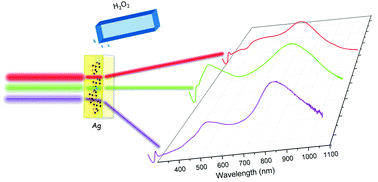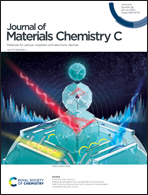Monochromatic light driven synthesis and growth of flat silver nanoparticles and their plasmon sensitivity†
Abstract
The size and shape of metal nanoparticles play a key role in most of their technological applications because they determine their optical properties in the UV-vis-NIR range as well as their interaction with molecules in the surroundings. In this paper, we demonstrate the “in liquid” formation of flat silver nanoparticle colloids through the use of pulsed laser beams and monochromatic LEDs. The transformation of spherical to flat nanoparticles is driven and sustained by the addition of H2O2 and citrate under the irradiation of light. In this respect, it is demonstrated that high citrate concentrations limit the growth of some crystalline facets, yielding smaller plates with the plasmon resonance of the final colloid confined to the visible region, while the use of lower concentrations results in the formation of large plates with resonances in the near infrared region. Thus, the manipulation of citrate concentration in the solution and the choice of the irradiation wavelength give rise to the possibility to tune the position of the main plasmon resonance across the visible and near IR part of the spectrum. Plasmon sensitivity measurements show that nanoplates irradiated at the longest wavelength showed the highest response to a refractive index change.



 Please wait while we load your content...
Please wait while we load your content...